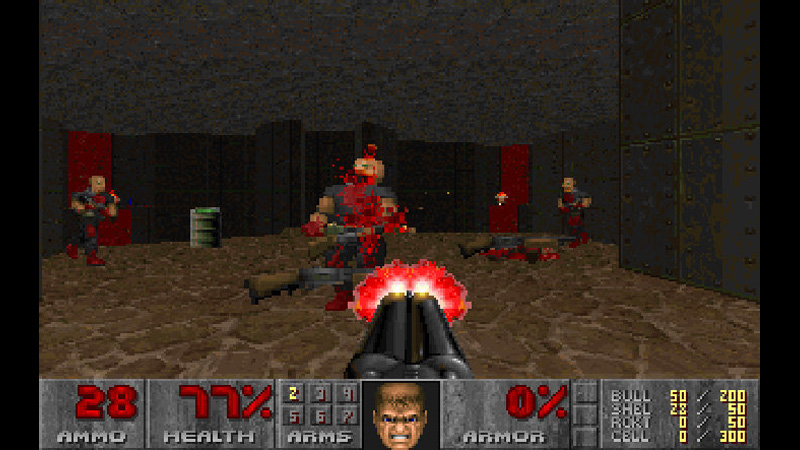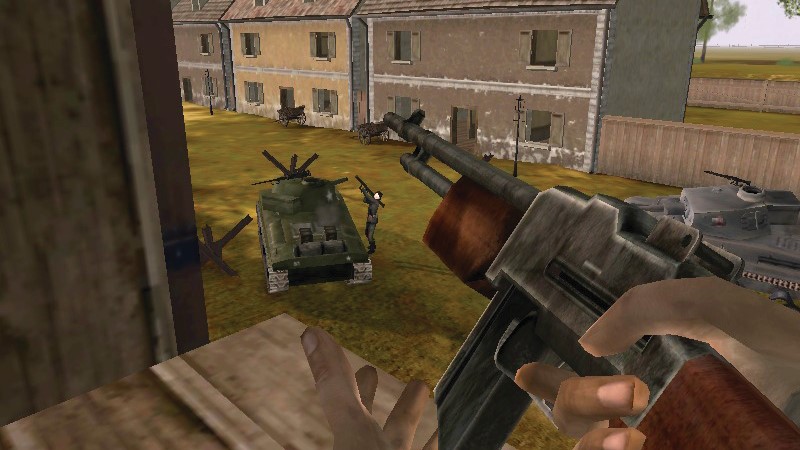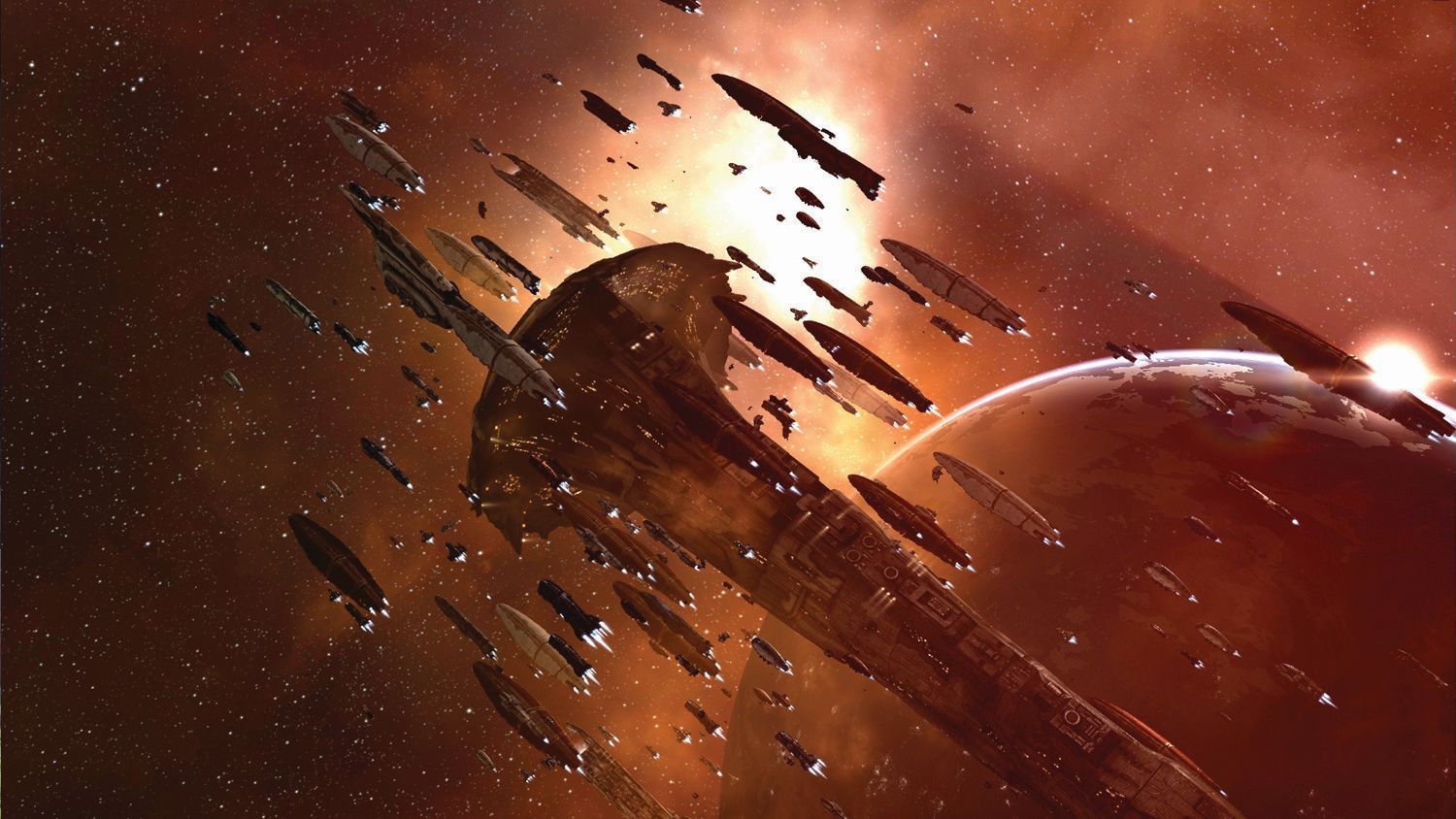The most important games and moments in 30 years of PC gaming, part 1: 1993-2003

This article first appeared as part of a supplement included with our blowout 30th anniversary issue of PC Gamer magazine, issue 390, in November 2023. Pick it up for even more great content, including a look back at the magazine's own storied history over the last three decades.
If you haven't heard, PC Gamer turns 30 this month. But it wouldn't be right to celebrate our own anniversary without celebrating 30 years of PC gaming itself too. There's too much history to truly cover it all, so we've decided to focus in on some of the most pivotal moments—the games and software that defined each era, the hardware that let us run it, and the events and moments that made us look at them in new ways. Let's kick it off with the first decade, 1993-2003, and the game that started it all for so many of us...
???? Part 2: 2004-2013
???? Part 3: 2014-2023 [Coming soon...]
Doom (December 1993)

Strictly speaking, PC gaming didn’t start with Doom. Spiritually though, it absolutely did. Doom embodies so much of what would define PC gaming across the next three decades. Its cutting-edge tech established the PC’s reputation as a premium gaming platform. Its immersive, satisfying gunplay made first-person shooters the PC’s mascot genre. Its emphasis on violence and horror expanded the medium’s reputation beyond a pastime for children. It even took the first steps toward online multiplayer.
Doom’s influence on PC gaming cannot be overstated. Yet what’s most remarkable about id Software’s landmark shooter is its sheer sticking power. Far from being a fondly remembered relic, Doom is one of the most widely playable games in existence, having been ported not just to every gaming platform, but every piece of technology with a screen. Its engine, made open source in a truly visionary move by John Carmack, birthed the PC’s unique, endlessly creative modding scene. Doom mods are still making waves today. There are even whole new games being made in Doom’s engine, like ambitious shooter Selaco, due out next year.
While Doom’s cultural omnipresence is remarkable, it can make it easy to lose sight of the game at the centre of it all, which remains a fantastic experience today. Although visually primitive by modern standards, mechanically it retains its delicate balance of weight, flow, and reactivity. Its weapon roster is still the blueprint for most single-player shooters, while its shotgun remains the baseline for all videogame firearms, and its 3D mazes still have much to teach about level design.
Moreover, for all the games that have imitated it, Doom’s distinctive atmosphere and pacing have proved oddly hard to replicate. Even its own follow-ups fell to either side of the original’s distinctive blend of action and horror. Thirty years on, there is still something elusive at the heart of Doom, which more than anything else is what defines it as a masterwork.
E3 begins (June 1995)

To understand the significance of E3’s arrival, you need to know how games were treated before E3, at other technology trade shows like CES. “In 1991, they put us in a tent,” said Sega America’s then CEO Tom Kalinske, “You had to walk past all the porn vendors to find us. That particular year it was pouring rain, and the rain leaked right over our new Genesis system. I was just furious with the way CES treated the videogame industry, and I felt we were a more important industry than they were giving us credit for.”
The first E3 was born as a response to this kind of treatment, a trade show designed to promote gaming’s growing commercial and cultural significance, rather than obscure it. Held from May 11-13 at the Los Angeles Convention Centre, the first E3 saw exhibitions by the likes of Sega, Nintendo, Sony, Activision, EA, Capcom, Microsoft, and LucasArts. Showcased PC games included Descent, Discworld, Wing Commander 3, and Syndicate Wars.
Although technically a trade show meant for industry professionals, E3’s cultural significance gradually broadened, gaining global public attention after the turn of the millennium. Simple game and console showcases morphed into extravagant stage presentations by big publishers. E3 could even affect how games were made, with huge amounts of developer resources being funnelled into making an E3 demo that would wow people. Having the public’s eyes on E3 was something its organisers were dubious about, and between 2008 and 2010 the show was closed to all but handful of professionals, with attendance dropping by 90 percent.
While it's been largely dominated by console manufacturers, E3 has witnessed some explosive PC gaming moments, like the positively futuristic demo of Doom 3 in 2002, and the hugely anticipated showing of Half-Life 2 the following year. In 2015, the PC Gaming Show was launched in association with PC Gamer, bringing attention to all the fantastic PC games that don’t have a massive publisher behind them.
In 2020, E3 was cancelled for the first time due to the Covid pandemic, and with the exception of an online event the following year, the show hasn’t returned since. While there have been events in its place like Summer Games Fest, nothing has yet managed to replicate E3’s collective celebration of videogames. We can only hope that it returns someday.
Quake (June 1996)

While there are many shooters like Doom, there’s nothing quite like Quake. With its peculiar mix of gothic fantasy and industrial horror, id Software’s 1996 shooter remains a singular entity in the annals of the FPS. Even its own developer has never revisited the series’ original design, choosing instead to go down a more sci-fi route for the sequel.
Perhaps that’s because Quake was born from id Software’s tensions as much as its talent. With a lengthy (for the time) development cycle, Quake’s creation was plagued by multiple redesigns and personality conflicts, culminating in John Romero’s departure from the company. It’s one of the earliest insights into the mounting pressures upon blockbuster game developers, which would only increase as ambitions, budgets, and development cycles ballooned.
Nonetheless, Quake is still a landmark entry in the gaming canon. Its true 3D graphics engine represented a huge advance over Doom. It was also the first id game to feature mouselook, bringing added responsiveness and verticality to its gunplay. Special mention should be given to Trent Reznor’s buzzing, ominous soundtrack, which remains one of the most distinctive musical scores of any game.
Of course, Quake’s most significant contribution to the PC gaming landscapes was its multiplayer. John Carmack’s revolutionary netcode made Quake playable across dial-up internet connections, paving the way for everything from Counter-Strike to Call of Duty. Its fast-paced, competitive deathmatch also saw the earliest pro gamers rise to prominence, like Dennis 'Thresh' Fong and Stevie 'KillCreek' Case, laying the groundwork for today’s global esports scene
Ultima Online (September 1997)

Ultima Online was to MMOs what Doom was to first-person shooters. It may not be the original massively multiplayer game, but it was the first to demonstrate they could have global appeal. While Ultima takes place in a typical fantasy world, it’s closer in spirit—mechanically speaking—to EVE Online than World of Warcraft, a player-driven sandbox with a dynamic economy and persistent housing for its players. The game was also the scene of gaming’s most famous instance of griefing, when Origin co-founder Richard Garriot’s "Lord British" avatar was assassinated during a beta test. The more things change…
Fallout (October 1997)
When Fallout arrived in late 1997, the CRPG was dead. PC gaming was all about action and attitude in the '90s, and Fallout’s success came from channelling some of that attitude back into the RPG. Its satirical post-apocalypse and snappy branching narrative let players be a badass, a hardass, a dumbass, and every kind of ass in between. Fallout’s isometric perspective and adaptive quest design made it the template for the modern CRPG, and its legacy is still visible in games like Baldur’s Gate 3.
Voodoo2 (March 1998)
The Voodoo Graphics card from 3dfx introduced hardware acceleration in 1997, but it was the Voodoo2 that really showed what GPUs could do. Not only did it boost resolutions from 640x480 to 800x600, but you could pair two of them together to crank that up to 1024x768. The Voodoo2 also supported dual texturing per pixel, which made games like Quake 2 and Unreal look phenomenal. The Voodoo2 represented the most dramatic advancement in computer graphics since the advent of 3D, and catalysed the advancement of computer graphics across the next decade. Sadly, 3dfx wouldn’t survive to see it.
StarCraft (March 1998)
Today StarCraft is best known for two things: its national following in South Korea, and the resulting esports scene. But there’s a reason why StarCraft could capture the hearts of a nation: it’s the RTS honed to perfection. Blizzard took the fundamentals already refined in its WarCraft series, and transposed them into a vibrant sci-fi universe centred around three asymmetric factions. Mastering their particularities is what kept players coming back for the next decade, and what ultimately made StarCraft one of the keystones of the nascent esports scene. Even after the colossal success of StarCraft II, the original remains reasonably popular in its spiritual homeland
Thief: The Dark Project (December 1998)

Looking Glass’ gothic fantasy was a dedicated sneaking simulation. Its lighting system let players disappear into the shadows, while its advanced audio propagation meant every step you took had to be carefully considered. It also features some of the best 3D level design around. Missions like Assassins and The Sword have become key reference points in the level design handbook. Thief’s framework would filter through to pretty much any game where the screen goes slightly darker when you crouch. Yet while countless games include stealth in their toolset, Thief remains the best dedicated stealth adventure in existence
Age of Empires 2: The Age of Kings (September 1999)
Twenty years after its release, Age of Empires 2 is still getting expansions. That’s a testament to how universally beloved the historical RTS is. Age of Kings brought the series from the slightly stuffy classical era into the more popular Middle Ages, adding new features like advanced AI, improved isometric visuals, and the ability to build big-ass castles. In more recent years, Age of Kings has received not one but two overhauls. The HD edition launched in 2013, while a Definitive Edition released in 2019, introducing new playable factions and new campaigns. Few games have stood the test of time this well.
GameMaker releases (November 1999)
In the 1990s, there were two ways into game development. Either you learned to code, or you learned how to mod. Then, in 1999, a Dutch scientist named Mark Overmars released a simple graphics tool called Animo. The tool gathered some attention, and Overmars began adding new features like a particle system and networking. He also changed its name to GameMaker, which in time would become emblematic of the democratisation of game development. Since 2007, GameMaker has been developed by Dundee-based company YoYo Games, and has been used to make games like Hotline Miami, Gunpoint, and Undertale.
Deus Ex (June 2000)

Deus Ex represents the culmination of PC gaming’s innovations throughout the 1990s. Here was a game that gave you the shooting of Doom, the sneaking of Thief, the ability to talk your way around a problem à la Fallout, all in one astonishing package.
It was a long-awaited triumph for the immersive sim, an offshoot of the RPG that emphasised systems-driven worlds designed to facilitate player agency. Immersive sims had been pioneered by Looking Glass Studios throughout the 1990s in games like Ultima Underworld and System Shock. Yet while beloved by those in the know, their commercial success had been negligible.
Deus Ex boasted greater ambition and flexibility than those games, but it also took place in a more relatable world. A near-future cyberpunk dystopia where every conspiracy theory you can imagine was true, Deus Ex’s world was governed by shadowy organisations, fought over by rogue AIs, and ravaged by a pandemic. In an age of online misinformation, its perspective on conspiracy theories can seem a little quaint, but it’s also startlingly relevant in places. It has nuanced discussions about how power structures work, how government can slide into dictatorship, the problems of unregulated technology, the surveillance state, and so much more.
Sadly, Deus Ex’s success didn’t lead to a new golden age of immersive sims. Yet it was influential enough to keep the flame alight, leading to several excellent follow-ups (and Invisible War) while also influencing games like Dishonored and Cyberpunk 2077. But the original remains the genre’s best mix of intricate systems and insightful storytelling.
Windows XP (August 2001)

Microsoft’s Windows OS was transformative for PC gaming, offering a level of stability, compatibility, and accessibility that simply didn’t exist in the era of DOS. Gone were the days of typing text commands to install and boot games, getting it wrong several times, then throwing your keyboard out the window.
Although Windows 95 represents the key turning point from command lines to icons, Windows XP is Microsoft’s crowning achievement in OS design. Its UI replaced the unsightly grey boxes of old with a sleek, colourful, and above all intuitive design. It overhauled the Start menu introduced in Windows 95, adding the two-column layout. It also introduced a bunch of new features like taskbar window grouping and fast user switching.
But what made XP such a triumph was its reliability. At a time when every PC game came with the risk that it might Just Not Work, XP proved remarkably compatible. Even games that were years old by that point, like Quake and Half-Life, would generally run without complaint.
XP was the first truly modern PC OS, and its quality is evident in its longevity. Microsoft continued official support for XP until 2012. By comparison, Windows 95’s support ended just six years after its launch. XP’s reliability helped power Microsoft through the embarrassment that was Vista. Even when the much-improved Windows 7 released, many users stuck with XP until the death.
Battlefield 1942 (September 2002)

The turn of the millennium saw PC gaming ask itself two big questions. The first was “What if you could play multiplayer shooters in teams?” while the second was “What would it be like to fight in the Second World War?”.
Battlefield 1942 answered both these questions simultaneously. In doing so, it spawned one of gaming’s biggest franchises. Battlefield took the renewed interest in WWII spawned by Saving Private Ryan (and in the PC gaming sphere, Medal of Honor: Allied Assault) combined it with the PC’s rapidly advancing multiplayer capabilities that facilitated games like Unreal Tournament, Counter-Strike, and Team Fortress, and then massively blew out the scale.
Not only did it support whopping 64-player battles, but those players could traverse vast, open-ended maps in vehicles like tanks and planes. The result was an unprecedented virtual cauldron for brewing player-driven action. A match of Battlefield was a thousand tales written and told simultaneously by amorphous groups of players. That time you took out a Stuka with an AA gun, or when you coordinated an armoured assault on a control point with your mates, or when you held off the German advance at El Alamein.
Battlefield has been a staple of PC gaming ever since, and while the quality of the individual games may vary, its core appeal has never diminished. Its influence is also undeniable: games like PUBG and Apex Legends owe an enormous debt to Battlefield’s open-ended multiplayer design, while even Call of Duty has taken a lesson or two from DICE in recent years.
EVE Online (May 2003)

Many games promise freedom, but EVE is one of the few that truly commits to it. Launched as a space MMO with a player-driven economy and an emphasis on PvP combat, what has come to define it are the shenanigans of its player-operated corporations. EVE Online’s virtual history is riddled with ambitious heists, daring assassinations, elaborate spy-games, and enormous space battles. There have even been times when its players have taken the fight directly to the developers. It’s a game built not just for the community, but around it, with developers CCP responding to players’ actions and treating them as part of the design.
Valve releases Steam (September 2003)
Valve's distribution service was never intended to be the gaming bazaar that it is today. It was made to solve a simple problem: how to patch Valve's multiplayer games in the most efficient manner possible.
The earliest version of Steam had no store, no community features, and certainly no trading cards. It was also roundly hated at a time when most homes still lacked internet connections, and was seen as a draconian anti-piracy measure, a threat to the freedom of PC gaming.
Eventually, Steam would completely change how PC games are purchased, owned, played, and even made. All largely because of a certain game that arrived the following year: Half-Life 2.
Call of Duty (October 2003)
Today Call of Duty is known for its world-conquering multiplayer. But in 2003 it was the cinematic campaign everyone was excited about. Hot off the heels of Medal of Honor: Allied Assault and its recreation of Saving Private Ryan’s Omaha Beach landing, designers Jason West and Vince Zampella created a new studio. Call of Duty cast Allied Assault’s filmic eye across three campaigns, fighting through the hedgerows of Normandy as the Americans, assaulting the bridges of Holland as the Brits, and enduring the carnage of Stalingrad as the Soviets. It was a thunderous airstrike of a game, and for better or worse, the FPS hasn’t been the same since.
Head to part 2 for 2004 onwards. [Coming soon...]